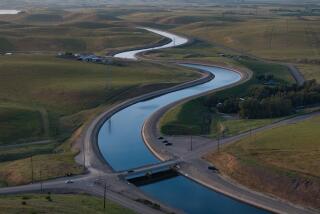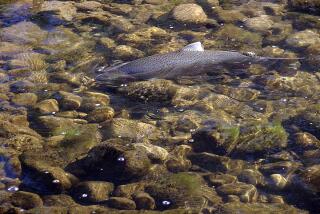Op-Ed: Can the Sacramento Delta survive more ‘regulatory flexibility’?

The state and federal Endangered Species Acts were created to prevent the extinction of our native fish and wildlife, and they’ve been tremendously successful. Yet despite these laws, California is on the verge of killing off some of its native salmon and other fish in the Sacramento-San Joaquin River Delta and San Francisco Bay, the largest estuary on the West Coast of the Americas.
Not just fish are at risk. Our state’s salmon industry is economically crucial to coastal communities and thousands of fishermen and fishing families. Salmon are also essential to the coastal ecosystem; for example, killer whales that migrate off California are threatened because of the decline of salmon, their main prey.
And when the rivers that feed the delta are unable to provide the cold, clean water that salmon require, the water there is also often unable to meet the needs of humans. During California’s historic drought, as fish populations have crashed, toxic algae blooms have begun to proliferate and in some areas, delta water has turned too salty for irrigation or consumption.
The drought is one important driver of this destruction, but it isn’t the only problem. Bad water management — in the name of innocuous sounding “regulatory flexibility” — has been weakening environmental protections and pushing the delta toward disaster.
Virtually no winter run Chinook salmon, protected under the Endangered Species Act, survived in the Sacramento River in 2014 or in 2015. Fall run Chinook salmon, a separate, unlisted species that is the backbone of thousands of fishing jobs all along the West Coast, also suffered huge losses. Because salmon have a three-year life cycle — and we’ve now killed so many in the river — another year of sacrificing the environment to other interests could be the last straw.
In dry years, built-in regulatory flexibility automatically reduces the share of water that flows into the delta, allowing more of it to be diverted. Over the last two years, however, agencies have waived and weakened water quality standards and other environmental protections even further in order to provide water for interests such as agribusiness. From 2014 through 2015, about 1.35 million acre-feet of water (more than twice the amount of annual water use in Los Angeles) that should have helped protect delta fish, wildlife and ecosystems was diverted.
Republicans in Congress are trying to use the drought as an excuse to weaken, suspend or even repeal protections for salmon and other endangered species.
Such shortsighted water strategies can have long-term consequences. How we manage the difficult challenge of apportioning water supplies during droughts may have repercussions that last for decades. For example, the operation of Shasta Dam during the 1987-92 drought caused a massive kill off of winter run Chinook salmon in the delta and in the Sacramento River, and led to its initial listing — and new environmental regulations — under the Endangered Species Act.
Still, Republicans in Congress are trying to use the drought as an excuse to weaken, suspend or even repeal protections for salmon and other endangered species. The House has passed four bills (some before the drought) and pushed numerous riders on other legislation in order to overturn state and federal regulations that balance delta water use for environmental as well as other purposes. So far, the bills have been stopped in the Senate.
California’s voters want to keep it that way. In September, the USC Dornsife/Los Angeles Times poll found that a majority of voters statewide oppose suspending environmental protections for fish and wildlife during the drought. They see through this one-sided approach and understand that agriculture and the environment both require that we invest in sustainable water supplies.
Even if rain and snow continue in California, storage in the state’s reservoirs is so low, and the health of the delta is so imperiled, that Congress needs to encourage less water diversion — less pumping — from the Sacramento-San Joaquin watershed.
California’s hotter and drier future means that water will remain a precious and limited resource. The best strategy for coping with it isn’t the ruination of the delta and the salmon fishery. It’s doing what Los Angeles is doing — aggressively moving to cut water imports from the delta by 50% by 2025, conserving water and rethinking local infrastructure to capture rainwater and improve groundwater. Such actions will increase the reliability of water resources, create local jobs and protect the environment and economy.
We can have both a healthy environment and economy — including agriculture. But if we continue to sacrifice environmental protections instead of investing in long-term water solutions, we will probably have neither. And that will affect all of us.
Doug Obegi is a senior attorney with the Natural Resources Defense Council’s water program.
Follow the Opinion section on Twitter @latimesopinion and Facebook
More to Read
A cure for the common opinion
Get thought-provoking perspectives with our weekly newsletter.
You may occasionally receive promotional content from the Los Angeles Times.






